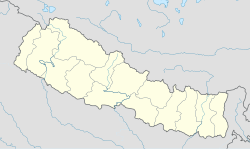Kaskikot
|
Kaskikot कास्कीकोट |
|
|---|---|
| Village Development Committee | |
| Location in Nepal | |
| Coordinates: 28°16′19″N 83°54′05″E / 28.27194°N 83.90139°ECoordinates: 28°16′19″N 83°54′05″E / 28.27194°N 83.90139°E | |
| Country |
|
| Zone | Gandaki Zone |
| District | Kaski District |
| Population (2015) | |
| • Total | 27.8 Million |
| Time zone | Nepal Time (UTC+5:45) |
| Website | http://ddckaski.gov.np/ne-vdc-information/ |
Kaskikot (Nepali: ), commonly known as Kaski, is a Village Development Committee (VDC) in Kaski District in the Gandaki Zone of northern-central Nepal.
Kaskikot is located in the Annapurna Massif, north of Fewa Lake and 12 km west of Pokhara after Sarangkot. Kaskikot is on the treking route to the Annapurna region. A mountain side ridge at an altitude of 1,788 m provides panoramic Himalayan views. On the northern side of Kaskikot, Dhawalagiri can be seen in the far west. The Annapurna mountain range is clearly visible on the same side. To the east, the village overlooks the city of Pokhara across Fewa Lake.
It shares territory with Sarangkot, Chapakot, Dhikurpokhari and Hemja.
Before the unification of Nepal there were 24 small principalities in west Nepal, one of which was Kaski. The ruins of the old palace of the rulers of Kaski can still be seen in Kaskikot. During Dashain holidays various cultural events take place there. This historical kingdom was an early homeland of the Shah dynasty. Kulmandan Shah was one of the rulers who established his Kingdom in west Nepal. His descendant Drabya Shah was the first to establish Gorkha, source of the legendary Gorkha warriors.
Kaskikot Kalika Temple lies in the historical palace at the top of hill (1700 meters). During nava durga Dashain and Chaitra Dashain Kaski Guthi Sastha organize worship to goddess Durga Bhawani. According to historical data Risi Kasyap stayed Tapashya so Kaski was named in his name. Many people gather in Kaskikot Temple during Dashain Fulpati and Chaitra Dashain.
At the time of the 1991 Nepal census it had a population of 6,075 persons, residing in 1185 individual households. According to the census of 2011, this had decreased to a population of 5,892, with 1,508 households. The majority of people depend on agriculture. With majority of Brahmin, Chhetri, Thakuri, Magar, and Dalits resides in Kaskikot.
...
Wikipedia

